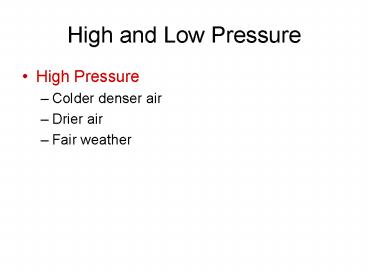High and Low Pressure - PowerPoint PPT Presentation
1 / 23
Title:
High and Low Pressure
Description:
Nor-easter Track. Wind flow shown for. Tuesday only. Usually highest snow fall ... nor-easter goes. out to sea and. Red Hook gets no. precipitation ... – PowerPoint PPT presentation
Number of Views:139
Avg rating:3.0/5.0
Title: High and Low Pressure
1
High and Low Pressure
- High Pressure
- Colder denser air
- Drier air
- Fair weather
2
High and Low Pressure
- Low Pressure
- Warmer less dense air
- humid air (more water vapor)
- Wet, cloudy weather
3
High and Low pressure systems appear like this on
a weather map, but what are they really like?
4
The spacing of the isobars determines the gradient
5
HIGH Pressure Systems are associated with the
following weather characteristics
1. cooler denser air
2. dry, low moisture content air
3. a clockwise flow or spin (anticyclone)
4. clear skies and fair weather
5. diverging air at ground level
6
LOW Pressure Systems are associated with the
following weather characteristics
1. warmer air
2. humid, high moisture content air
3. a counterclockwise flow or spin (cyclone)
4. cloudy skies and wet weather
5. converging air at ground level
7
Highs and Lows
8
Lows spin counter- clockwise
Coriolis Effect causes winds to turn to the right
in the northern hemishere
Highs spin clockwise
9
H
X
When highs are located north or west of our
area it pushes cool dry air over us
Red Hook
Note the wind flow in our region for a high
located above the Great Lakes
10
This is known as A Bermuda high
H
When highs are located south and east of us,
it pushes warm humid air over us
11
Lows are a bit more complex and are often
associated with fronts
Also, most highs and lows are started by bends in
the upper air flow known as the jet stream
H
L
A dip or trough in the jet stream produces
cyclonic flow or a low
An upward bend or ridge produces
anticyclonic flow or a high
12
Lets now look at how a typical low pressure
system (cyclone) develops in North America
Stage 1 a stationary front
13
Stage 2 a wave develops from trough in jet
stream
14
Stage 3 Cyclonic circulation established
A distinctive warm and cold front have formed
Warm sector
15
Stage 4 Occlusion begins and warm sector starts
to get pinched off (zipper effect)
16
Stage 5 - Occluded front develops warm sector
nearly gone
17
Occluded front side view
18
Stage 6 cyclone dissipates
The mixing of warm and cold air is complete
19
Wind flow shown for Tuesday only
L
Wed
L
Usually highest snow fall for Red Hook with this
track
Tuesday
L
Monday
L
Sunday
Nor-easter Track
20
Day 3
Why would this track bring rain or
mixed precipitation to Red Hook in winter?
L
L
Day 2
L
Day 1
Wind flow shown day 3 only
21
On this track the nor-easter goes out to sea
and Red Hook gets no precipitation
L
Day 3
L
Day 2
L
Day 1
22
To understand why storms usually track in a
northeast direction we need to look at our
old friend convection
Convection is what drives the global winds,
which is caused by the unequal heating of the
Earths surface
Recall that the equator is a heat source and
the poles are a heat sink
23
high
low
(convergence)
high
(divergence)
Low
(convergence)
(divergence)
high
(convergence)
low
high































